Tagged: Social media
My "Unplugged" Summer
- by Alyson Shane
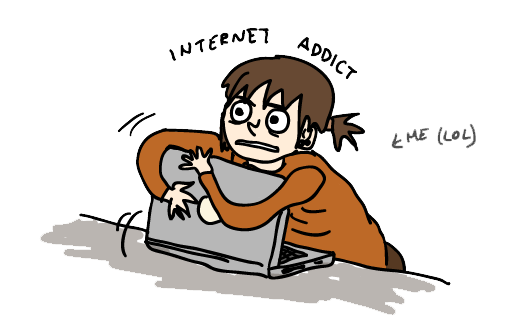
Stunningly accurate image via iam-kerri on DeviantArt
I'm addicted to social media.
Most of us don't want to say it out loud, but we're addicted to the info/updates/likes/comments cycle that social media and mobile technology has brought into our lives.
As someone who spends the majority of her time thinking about branding and generating social content (both personal and professional), I may be a bit hyper-sensitive to this reality, but it's true: most of us are addicted to our smartphones.
I've known this for a while, but earlier this summer I read an article on CNET that really bothered me. The TL;DR is that our phones make us stupid. Whether they're on, off, turned face down... whatever; having your smartphone in the room with you decreases your ability to think and concentrate, making you less productive and inherently less capable overall.
With this in mind, I decided to run an experiment of sorts: I made a commitment to myself to find opportunities to physically distance myself from my phone in order to be more engaged with the world around me throughout the summer.
It's been an interesting few months, and here are the takeaways:
I Read More Books
On average, I read maybe half a dozen or so books a year.
I'm not sure what you read on an annual basis, but I've always been a voracious reader and could easily power through a whole novel in a few sittings (I read all of Stephen King's "The Shining" in a day when I was a younger) so I've definitely noticed my declining ability to sit down and read a book in the last few years.
I do most of my reading before bed, which is problematic because I use my phone as my alarm clock (a bad habit that I'm not ready to let go of, if I'm being honest) so I had to set aside time to read during my days instead, or make a point to leave my phone in another room while I was reading.
Here's how many books I've read and finished in the past 4 months:
- On Writing - Stephen King
- Lady Oracle - Margaret Atwood
- Her Fearful Symmetry - Audrey Niffenegger
- Women - Charles Bukowski
As you can tell, I averaged about a book a month, which is well beyond my annual average. I'm still significantly slower than I used to be, but it reminded me that in order to enjoy and make your way through a novel you have to sink down into it, which is something I struggle to do whenever my phone is present.
I honestly thought that it wouldn't be as noticeable as the CNET article made it out to be, but I was floored by how much more easily I could enjoy a book when I couldn't just reach over for my phone.
**I should point out that I read on average 6-12 articles a day; some for work and some for leisure, so I don't think how much I read has decreased; only what I read, and in which format.**
I Was Fully Present
This one was the hardest.
We go to a few festivals a year, and do some camping with friends in addition to those events, and I promised myself that I was going to keep my phone in my tent and on airplane mode (because I still have to check work from time to time) instead of keeping it on my person.
I realized that I'd been using "taking photos" (something I do, but not as regularly as I used to) as an excuse to keep my phone - and the comfort it gave me - around even when I didn't need it.
The hardest part of this exercise was "memory FOMO" or, worrying that I wouldn't have anything to populate my social feeds with when I returned to my everyday life. I saw people taking photos and videos on their phones around me and would often self-judge for not doing the same, which was a new and unpleasant feeling.
Instead, I'd just take a deep breath and experience as much of the present moment as possible. It was hard but, you guys, it was so good.
I Enjoyed Myself More
The biggest change (and challenge) was allowing myself to live in the present moment as fully as I possibly could.
Because of what I do for a living, I often frame content (photos, and the like) with a plan in mind: how do I want this to look? How does it reflect my personal brand? Which hashtags can I use to connect this with a broader community?... and so on.
Not having my phone glued to my palm the urge to check updates, post photos, and record my life for future social media content didn't entirely eliminate my FOMO, but it did act as a reminder that the only way to hold onto my memories was to immerse myself in what I was doing, or what was happening around me.
In a world dominated by Snaps, Boomerangs, and hashtags, it was nice to find a few moments of solitude where my digital life didn't interfere with my physical one.
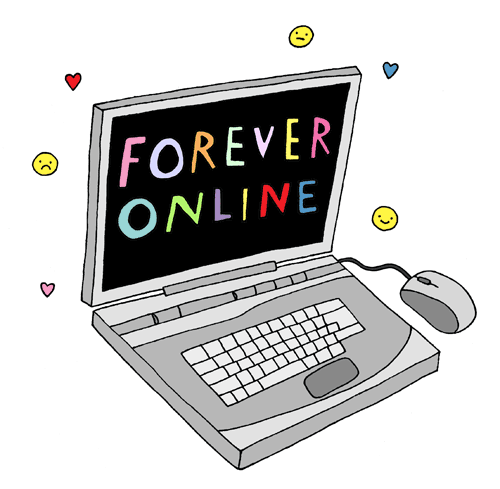
Wanna Try, Too? Here's What You can Do
Going "unplugged" doesn't have to be a totally terrifying prospect (as it was for me before I started this experiment) but here are a few things that I did to help lessen my dependency on my phone that you can try, too:
- Keep your phone out of sight, or in another room, when not in use.
- Don't browse before bed! Instagram black holes steal your sleep. Read a book instead.
- READ MORE BOOKS. I prefer fiction but choose the topics you love best.
- Leave your phone in your tent while camping.
- Alternatively, leave your phone in your car, or in your purse/bag, while out with friends.
Of course, there are lots of other ways you can go "unplugged" for any extent of time, but these should set you on the right track!
Do you have any experience "unplugging" or ditching your digital device? Tweet at me or tell me in the comments!
Join me for a lunch + learn dedicated to personal branding
- by Alyson Shane
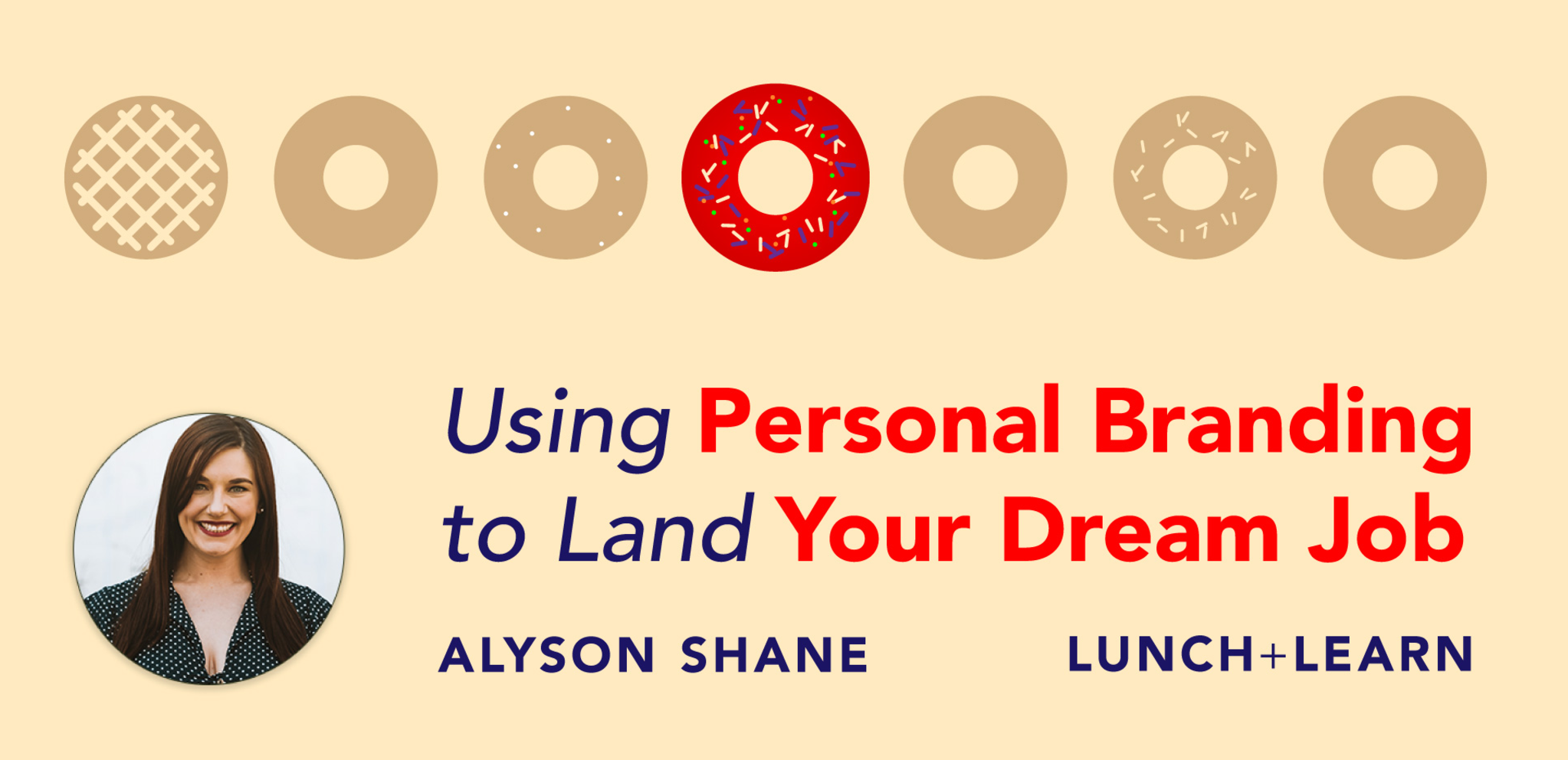
Figuring out who you want to be is daunting by itself - but what about figuring out who you are online?
If you've never thought about it before don't worry. Most people don't! In fact, most of us go about our daily lives, posting whatever we find, ranting about people that annoy us, and generally not giving a second thought to how the things we share might make us look to others.
Enter personal branding: the process of using social media and your digital presence to shape the narrative about who you are, what you do, and why you rock.
Why Does Personal Branding Work?
Many people think of personal branding as being inauthentic, or deliberately trying to pull the wool over people's eyes, but they couldn't be more wrong! I like to think of personal branding as the daily practice of putting your best foot forward and projecting the best version of yourself online.
Think about it this way: you're a smart, savvy professional who works hard and knows their shit, so why wouldn't you want people to know that about you right from the get-go?
What Can Personal Branding Accomplish?
I can say unequivocally that I wouldn't be where I am without my personal brand.
I realized several years ago (while I was in university, actually) that developing a strong presence online would help me get a job in my desired field and make connections, but I didn't really think too critically about it.
I posted to Twitter a lot and blogged regularly, which helped me start speaking and even landed me a segment on Shaw TV, but it wasn't until I shifted the focus of my website to be more "career-centric" and started sharing articles relating to social media and my industry that I started to acquire freelance clients and more speaking opportunities.
The more I shared, the more people began to see me as a local expert in my field, and as someone who could speak with authority about topics relating to my industry. I was able to accelerate this process by already having several years of online activity and recognition (aka, developing my personal brand!) to fall back on.
How Can You Develop Your Personal Brand?
Understanding how to shape your personal brand is one of the most valuable skills that we can learn in our digital age - I believe it's something we should teach everyone!
Luckily, there's no bad time to start developing your personal brand. It's really as easy as asking yourself some basic fundamental questions about yourself and your goals, signing in to your social accounts, and posting regularly.
Of course, there's a little more to it than that, which is why I'm hosting a lunch + learn with New Media Manitoba dedicated to helping you develop your personal brand!
Whether you're a student, freelancer, or professional looking to advance in your field and snag that killer new job, personal branding can help, and I'd love to show you how.
This event is FREE for NMM members, and only $10 for non-members, so what are you waiting for? RSVP and let's have some lunch and learn about how you can land your dream job by shaping how future bosses and clients think of you online.
Let's do this thing! Save your spot and let's get you that dream gig.
Write Better Instagram Captions in 5 Minutes or Less
- by Alyson Shane
Instagram is a visual social network by design, which means it's essential to focus on creating and finding eye-catching visuals to help your account stand out from the crowd... but what about the captions?
Many people don't realize this, but captions are one of the best tools at your disposal to help convey your message. Taking the time to write engaging, personal captions which express who you are (business or personal) and your reason for posting can go a long way towards helping keep your Followers engaged.
Luckily, sprucing up your Instagram caption game is as easy as can be! Let's take a quick look at how you can write a better Instagram caption in five minutes or less:
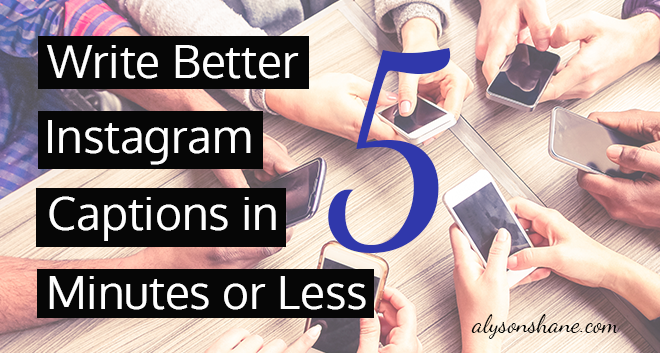
Use Your Instagram Captions to Sound Authentic
Before posting anything on Instagram, ask yourself: why should my Followers care about what I'm sharing? What sets my post apart from other, similar, content on this social network?
Some other things to ask when crafting your Instagram caption are:
- Does it tell a story?
- Does it help my Followers learn more about me?
- Does it sound personal and authentic?
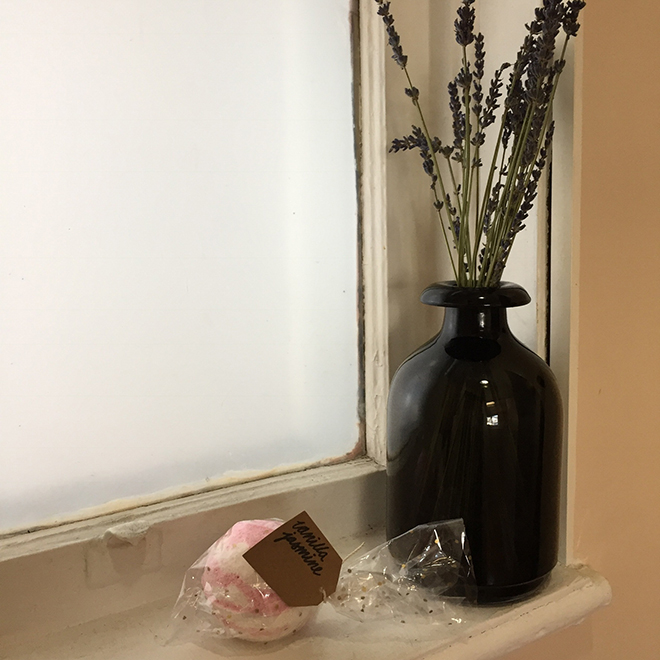
Let's use this photo of some lovely items I picked up from one of my favourite local shops, Public General Store to illustrate an example of what I mean.
Which of these two captions inspires you to take action?
Got some new stuff from @shop_public today. Check them out!
vs.
Yesterday I braved the cold to pick up some treats from my favourite new local shop, @shop_public. The dried lavender makes the house smell amazing, and I can't wait to relax with this vegan, handmade bath bomb from @blackflorawpg after a good skate. Make sure to check them out the next time you're in #WestBroadway!
See what I mean? Now my Followers know where I got the items, the reasons why I like them (local, handmade, vegan, etc), and have a personal recommendation to go check them out for themselves.
How does this example apply to my business? I hear you asking. Here's how:
Consumers demand more authenticity and personality from the brands and businesses that they interact with, the more "human" they want those interactions to feel. By using longer sentences and slang in the caption above it sounds more like... well, me.
I'm a person, and that's how I speak, so it makes sense that a brand wishing to emulate a "human" style would want to adopt a similar tone.
Use Your Instagram Captions to Tell a Story
Gone are the days when a brand could throw up an image and assume that consumers would buy based on the image, alone. Buyers in our modern economy are interested in how products and brands make them feel, and there's nothing that makes people feel good like being part of a story.
With this in mind, ask yourself: how can I wrap my products and posts in a story that will interest my Followers?
(Don't worry: if you're stuck here are a few suggestions to get the wheels in your head turning):
- Share a story about something that happened recently
- Mention specific customers, employees in your caption
- Get personal - share a success or struggle which relates to your image
- Share your favourites (places, people, food, products, etc)
- Talk about upcoming plans, dreams, and events
- Quote books, speakers, or people who inspire you and helped shape your brand
Use Your Instagram Captions As a Call-to-Action
Now that you've hooked your Followers with an interesting, authentic caption it's time to guide them to what you want them to do next. 70% of small businesses don't use a call-to-action in their marketing copy, which means doing so can give you a competitive advantage.
Stumped for a few effective call-to-action examples? I've got you covered:
- Check out the link in our profile for details
- Looking for more decor inspiration? Check out the link in our bio
- Tag a friend who...
- Share your experience/memory with us by tagging us in your photo!
- Leave a comment and tell us what you think
Encouraging your Followers to talk to you, share their stories, and get your brand involved will help with those feelings of engagement and participation in your brand's "story". Not sure how to tell your brand's story? Here's a comprehensive how-to on marketing your brand through storytelling.
Do you have any favourite tips on Instagram caption etiquette? Tweet at me or tell me in the comments!
Why We Need Twitter (or Something Like It) More Than Ever
- by Alyson Shane
For myself, and many people that I know, the world feels like an unfamiliar place right now.
The recent election of Donald Trump in the United States, and the apparent rise of white nationalism, anti-feminism, Islamophobia, homophobia, antisemitism, etc. (also known as the "alt right") has many people feeling scared and confused, and a lot of articles, from WIRED to Mashable, have emerged recently about the "echo chamber" that social media, particularly Facebook, has created which has led us to where we are today.
With that in mind, I wanted to discuss some of the ways in which I believe Twitter is actually getting things right in terms of providing a non-insular opportunity for people to express themselves, easily find dissenting viewpoints, and engage with them in conversation.

Before we begin
I know that there are a lot of dissenting views out there about Twitter, and it's usefulness as a social platform. Before I go too much further, let me get these things out of the way:
- Yes, I know that their CEO is wildly unpopular
- Yes, I know they have had issues addressing harassment and hate speech in the past
- Yes, I know that their value has tanked
- Yes, I know they have issues acquiring new users
This post isn't about any of those things.
What I'd like to do is discuss some of the things that make Twitter an important and necessary platform for our society right now, and how it (or something with the features I'm going to highlight) must continue to offer in order to allow for citizen journalism, the sharing of thoughts and ideas, and discussion online.
Hashtags (that people really use)
This morning I got up and read (on Twitter) that the cast of the Broadway musical Hamilton delivered a speech to United States vice-president elect Mike Pence at the end of their show last night. Within a few hours, right-leaning Twitter users took to the social network to start pushing a hashtag called #BoycottHamilton, urging (rather obviously) Trump supporters to boycott the play.
The fact that a hashtag emerged isn't what's important, but what you see when you click on the hashtag is:
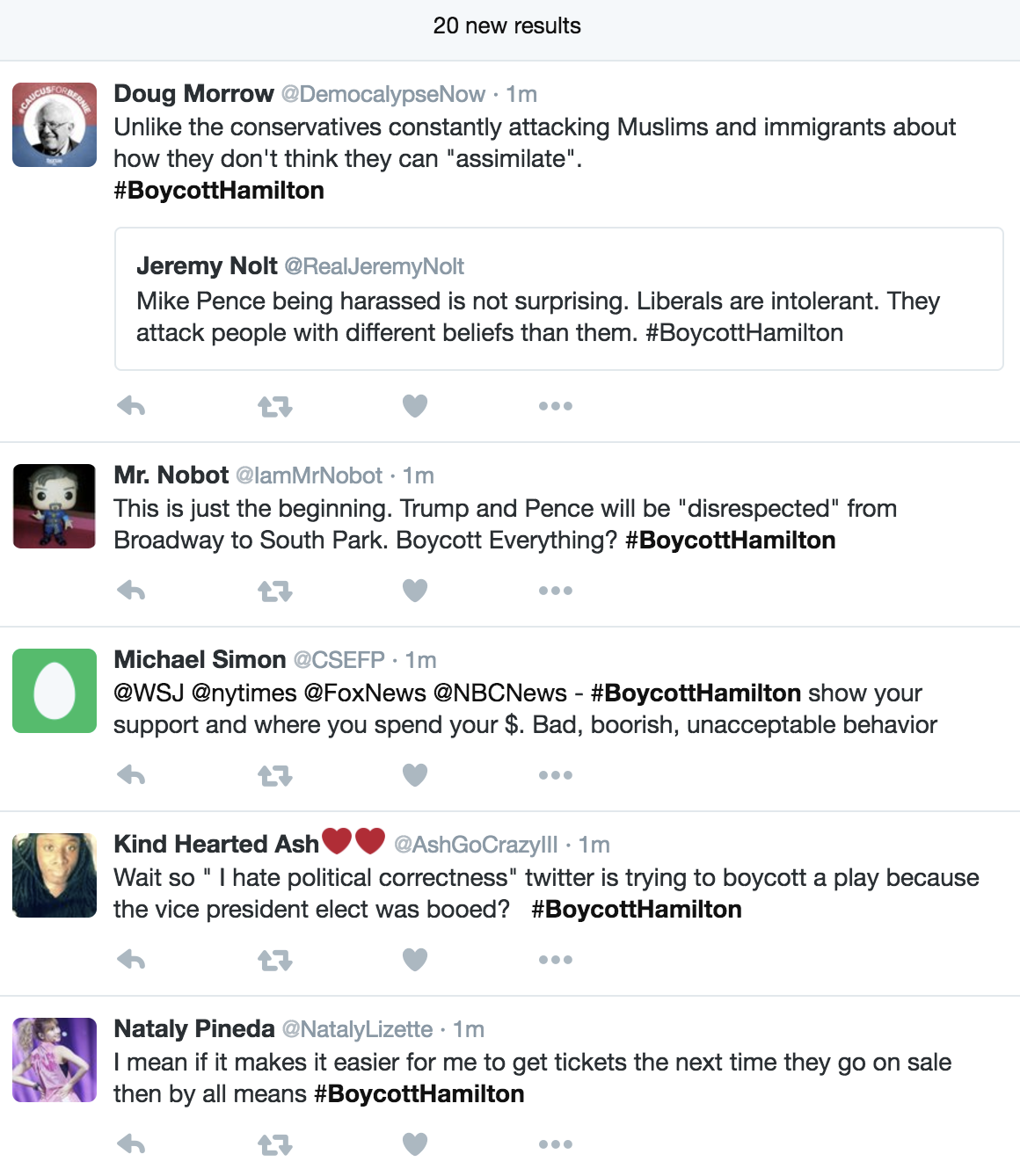
Even in this single snapshot we see a series of diverse opinions. Some don't take it seriously, some are worked up, etc. Not only does a timeline around a hashtag display diverse opinions, but Twitter also offers you this added level of engagement with a hashtag's tweets:
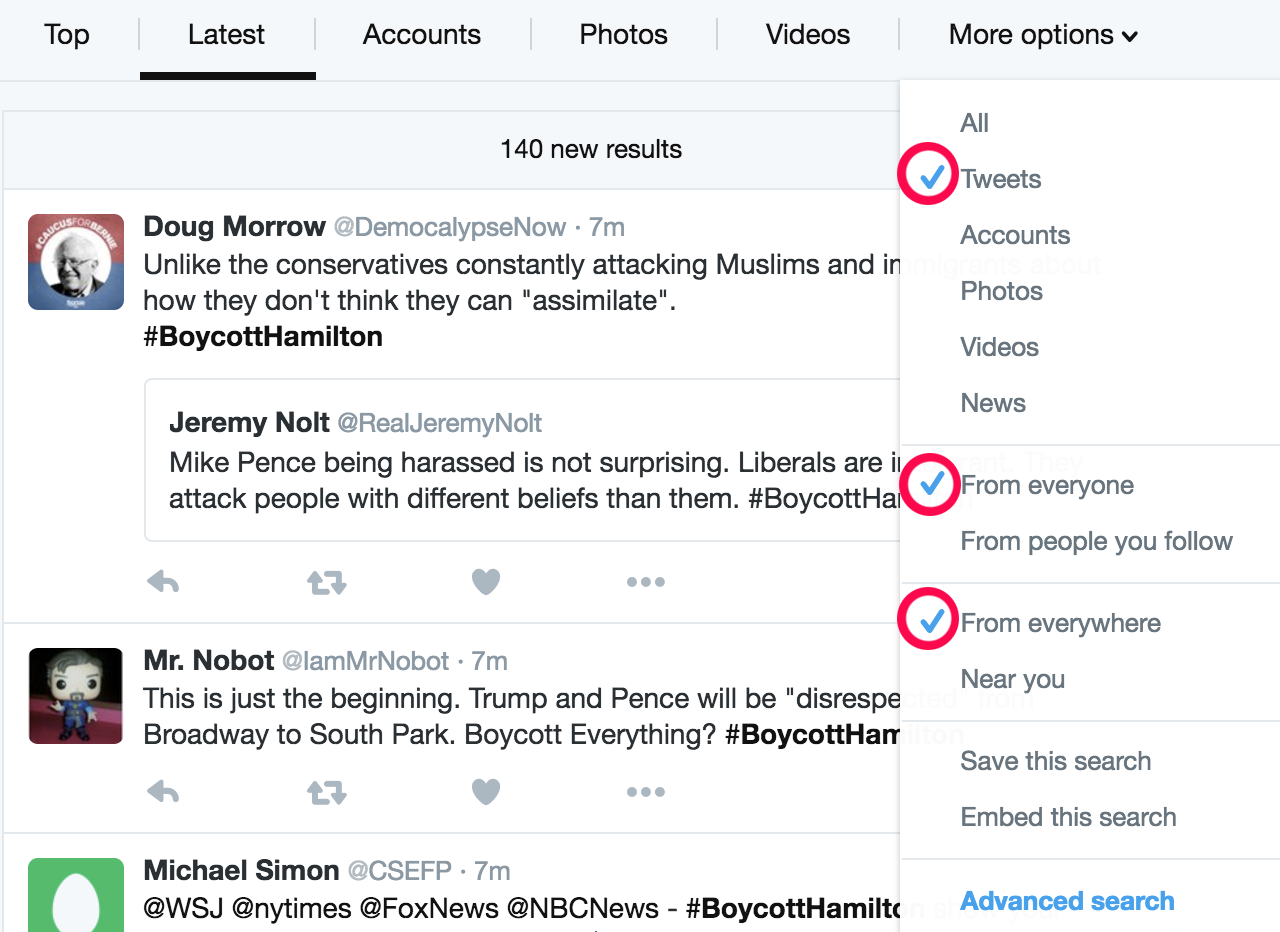
These settings are on by default. This means that in order to find yourself inside a Twitter echo chamber, you literally have to take the necessary steps to insulate yourself against opposing viewpoints.
Compare this to Facebook, which deliberately shows you news items and articles that appeal to you and goes out of their way to make changing those settings a challenge. Yes, hashtags are available to use on Facebook, but according to a 2016 BuzzSumo report, posts without hashtags received more interaction than posts with hashtags. This means that not only are hashtags not popular in Facebook, but that including a hashtag in your post actually lowers the likelihood that someone will engage with it.
So not only is Facebook pushing appealing news at you, but the primary tool at your disposal to find dissenting voices (a hashtag) are rarely used. This means that in order to find different opinions you either need to already be Facebook Friends with someone who disagrees with you, or you have to already subscribe to a Facebook Page or Group where you're likely to hear dissenting views.
But even in that scenario, you still have to actively seek it out, Like, and in some cases apply to join, a Group or Page which espouses views that you disagree with. Then, once you start expressing your opposing viewpoints you encounter the next hurdle: the wall of text. Which brings me to my next point:
Character and post length
Algorithms aside, one of the biggest differences when it comes to hearing opposing viewpoints online, and actually paying attention to them, is that Twitter forces you to be brief, at least in the context of a single tweet.
On Facebook there's no character limit, which means people can (and do) go on ad nauseam to explain their point of view. There's nothing inherently wrong with this, but it highlights the difference that Twitter acts like a conversation, while Facebook acts like a soapbox.
Being on the receiving end of a "Twitter storm" sucks; I can tell you from experience. But it's much easier to process and digest someone else's point of view in 140 characters than digesting (and responding to) several massive paragraphs (or, if you're unlucky, a single monolithic wall of text.)
Tweets, for all their faults, force people to break up their thought process, which provides opportunities for others to interject, respond, and get involved without having to unpack multiple paragraphs of text. I've engaged in debates with people on Twitter over a specific hashtag and more often than not both sides receive support from people who happened to see the conversation, and wanted to participate.
On the flip side, Facebook allows comments to be up to 63,206 characters in length, according to a 2016 HubSpot article. To put that into context: the average book is approximately 500,000 characters, meaning you can fit an entire novel in 9 Facebook status updates.
Just because tweets are shorter doesn't mean that they won't get ignored, or fluffed off, but when a Facebook user replies with a wall of text, a common sign of trolling, it's much easier to dismiss or simply ignore it.
Encouraging conversations
One of the points that I made earlier was about hashtags, and how searching for a hashtag meant that you could easily find differing opinions. It's also important to note that including a hashtag in your tweets also means that other people can easily find you.
Tweeting about a topic like #BlackLivesMatter, #Election2016 or #MAGA (to name just a few) will not only bring like-minded users out of the woodwork, but it's almost guaranteed that someone from the other side of the political spectrum will tweet back at you.
Tweets which include hashtags are 33% more likely to get retweeted than those that don't use them, and this (somewhat older) article from Sysomos which examined over 1.2 billion tweets in two months, which states that "29% of all tweets produced a reaction - a reply or a retweet. Of this group of tweets, 19.3% were retweets and the rest replies."
This 2016 report found that Twitter accounts for 30% of all global social sharing. At 500 million tweets sent each day (or 6,000 tweets every second), that's a lot of replies and retweets, even if Sysomos' 2010 numbers haven't grown since the article was published.
Not only does voicing your opinion on Twitter increase your chances of interacting with someone who disagrees with you, but when a discussion is retweeted, its visibility becomes amplified too. As more users participate, it increases the likelihood that you will run into someone who disagrees with you even more.
Default "public" profiles
Transparency is, in my opinion, the defining feature which makes Twitter such a powerful tool for discussion: when you tweet at someone your reply is completely public.
Unless you go out of your way to change your Twitter profile to "private," your entire tweet history including replies, retweets, quotes, and media will be available for any one whether they are logged in to Twitter or not. And if a tweet is retweeted, even deleting it later won't delete the retweet copy.
Facebook, conversely, was designed to be a more exclusive experience. From day one Facebook's defining feature has been a user's ability to selectively choose who can see what they share, and, for the most part anyway, the conversations you are able to have are limited to the amount of Facebook Friends you've approved, or the number of Groups or Pages you Like or participate in.
While the average Facebook user's Timeline isn't completely private (posts which tag other users, for example, will show up unless otherwise specified) and their comments may be seen if another user's privacy settings are more lax, overall what you say on Facebook isn't immediately available to the public in the same way that Twitter's Timelines are.
Yes, people are can be "outed" if they say something that another user disagrees with, but unless the person is a celebrity, political figure, or person of interest, the average user isn't going to re-share a hateful comment their coworker made and say "I never realized that so-and-so in Accounting was such an antisemite!"
We just don't call each other out in that way on Facebook at a personal level, and on Twitter, we don't really need to, because whatever a user posts is readily available to the world at large.
Easy access to a variety of opinions
Until recently, when we examined a specific historical event or time we had a limited number of sources to draw from. Nowadays, social media allows us to look into the life of the average person and experience, sometimes in real time, what they are experiencing.
Probably the most memorable of these incidents was the Twitter coverage of the protests over the 2009 Iranian election. Foreign media had been banned from reporting, and the stream of live coverage from everyday citizens on the ground led to a request from the U.S. State Department to put off scheduled maintenance which would have caused an outage in Iran during the protests.
Twitter provided the world with access to real-time information about a national crisis, and ever since has become the go-to source for breaking news including weather, political uprisings, and more. But it does more than just give us "on the ground" access to important events; it allows for public scrutiny of the facts, so that while false information will still get around, corrections have the chance of spreading in realtime too.
By using hashtags to discuss a common theme or event, Twitter users are able to contribute to a global and multi-faceted real-time narrative about what's happening in the world that they live in. Clicking on the hashtag they're using will show them a diverse array of opinions on the topic.
Here's another screenshot of some of the 'Live' #BoycottHamilton tweets:
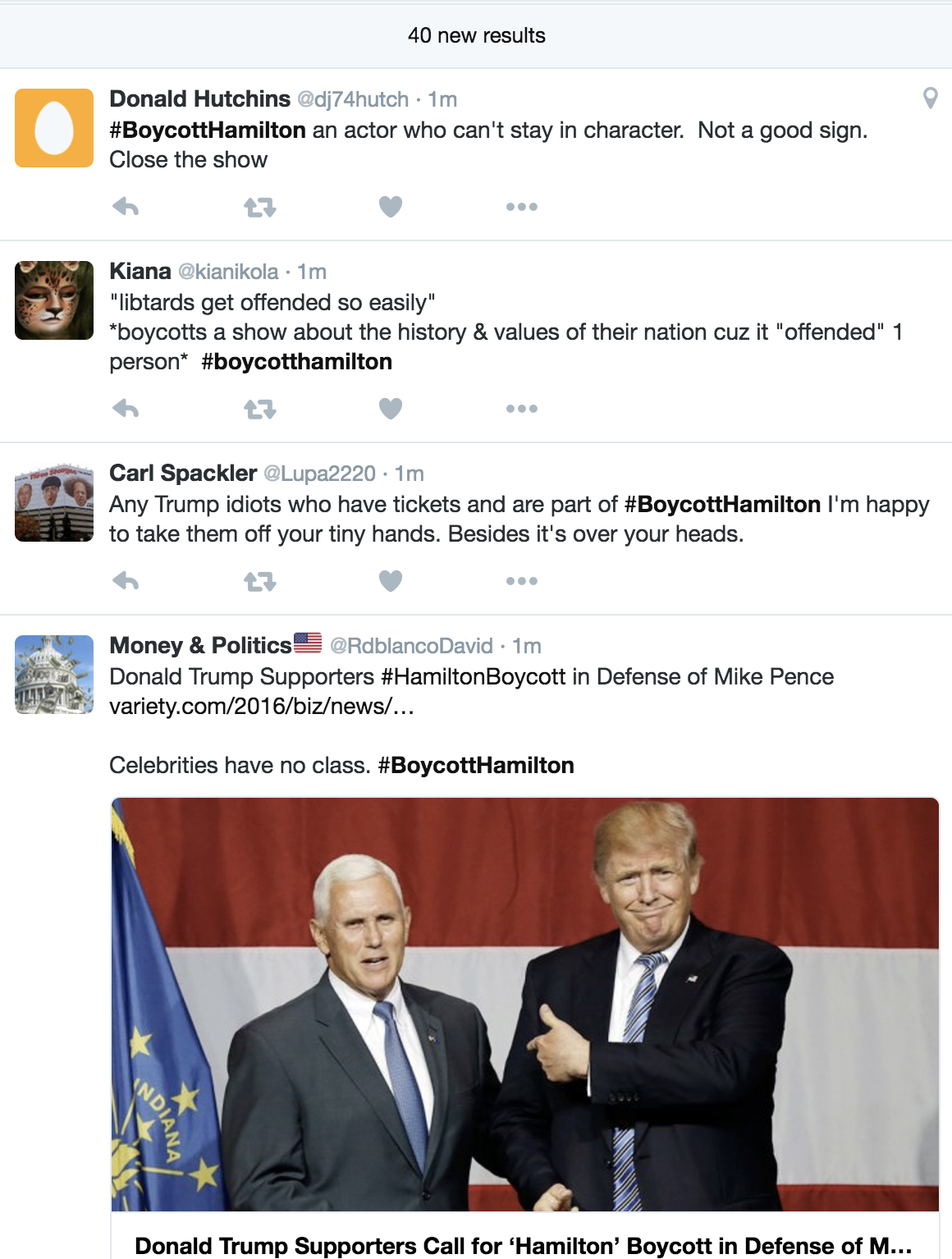
In closing
To be clear: I don't think that Twitter is the perfect platform. It has its share of flaws and issues, and eventually something will come along to replace it (hence the title of this post).
However, I do think that it's important to discuss the elements of the social network which I think make it good, and relevant. Twitter is an important tool for discussion and news, and provides more opportunities for users to engage with people outside of their "echo chamber."
Now, more than ever it seems, we need to be able to hear what other people have to say.
Debunking 3 Popular Social Media Myths
- by Alyson Shane
When it comes to social media, there's a wealth of information out there. A quick Google search for "social media tips" comes up with over 166,000,000 results. That's a lot of information!
Especially when you're first starting out, it may seem like there are so many "dos" and "don'ts" in terms of building an effective social media strategy, but while there are lots of great tips out there... I'm sorry to say that there are also a few myths which need to be debunked and removed from our collective memory.
What kinds of myths am I talking about? Let's take a look:
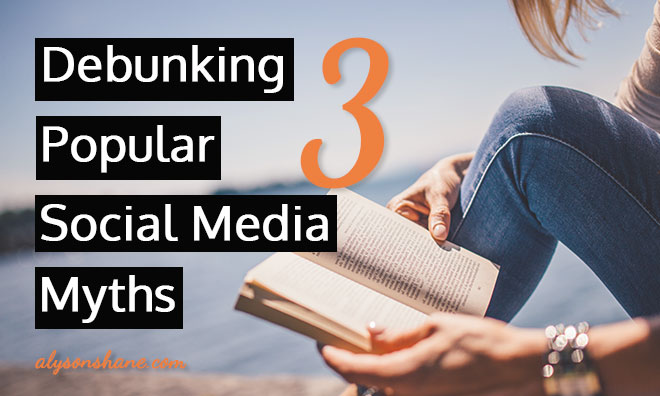
Myth 1: There's only one "right" time to post
This myth continues to exist because it's a well-intentioned one. Of course you want to post your content at times when your audience will be most likely to see it, right?
This is absolutely true, but what you need to keep in mind before you start pre-scheduling your content to go out every Tuesday at 4:45pm is this: do you know that that's when the majority of your target audience will be online?
This might be easy to figure out if your target audience happen to live in the same city as your business (if you're a local restaurant, for example) but if you're trying to reach a wider audience, and one which may even be in a different time zone than you are (say, if you're an international chain of restaurants) then you need to spend a little more time thinking about when they'll be online.
Myth 2: Your business needs to be on every social network
Often, one of the first things that a new client will ask me is: do I need to be on every social network?
The short answer, and the one I always give them is: no.
While it may seem like a good idea to get your name on as many social networks as possible, what you need to consider is the quality of the conversations and content that you can have on each network, not the quantity of them available for you to use.
it's also important to think about the kinds of people you want to reach, and where they spend most of their time online*. According to SmartInsights, 57% of Snapchat users are 16-24, whereas only 25% of the same demographic are regular Facebook users, and a paltry 29% are on G+.
So if your business is trying to target young people, Facebook and G+ may not be the best place to focus the majority of your marketing efforts.
Take the time to think about where your target audience are spending their time, and how your business can establish a presence on those social platforms. Otherwise, you'll just be wasting your time trying to connect with customers and clients who aren't interested in what you have to say or offer them.
Myth 3: You need to blog every day
Blogging is one of the most valuable tools at your businesses' disposal: it allows you to explain, in as much detail as you'd like, what your brand values are, what you offer your customers or clients, and your thoughts and insights in your industry, which can be helpful to your readers.
However, posting multiple times a day, or even multiple times a week, can actually damage your readership and reduce the flow of traffic to your blog.
Why does this happen? In a way, it's twofold: firstly, scarcity creates value. If your followers see that you're posting multiple blog posts every single day, then it's pretty likely that they will stop clicking through to read them because you're inundating them with information.
Secondly, people know that good content takes time to write, and if you're churning out blog posts faster than your readers can hit 'refresh', then it's pretty likely that the quality of the things you're saying isn't as high as it could be.
Instead of trying to post every day, aim for 2-3 posts a month of well-researched, well-documented content that will really help meet your readers' needs.
Did I miss any myths that need to be debunked? Tweet at me or tell me in the comments!
3 Things You Can Do Right Now to Get Noticed on Twitter
- by Alyson Shane
Without a doubt, the social network that people ask me about the most is Twitter.
Let me preface by saying this: the only reason I'm especially "good" at Twitter is because I've been an active user for a really long time. I first joined in December 2008 (thank you, Twitter) but didn't use it a lot at first. Part of that was that I didn't have a smartphone at the time, but the main reason I avoided it was because I didn't know what the heck to say.
Figuring out what is and isn't appropriate to share on Twitter and then trying to condense it down into 140 characters felt like a daunting and overly-complex experience, and for a long time I just "nope'd" out of it.
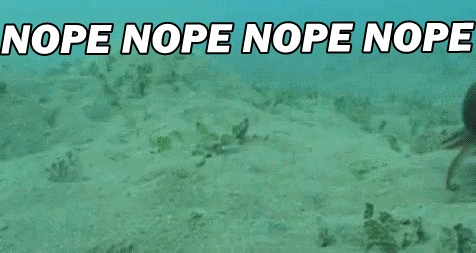
Eventually, though, I realized that I was over-thinking things way too much because (like all social networks) the main purpose of Twitter is to share your thoughts and talk to other people. That's it.
The issue that most people have with Twitter is that they over-think it. Too many people I know have asked me "is this okay to tweet?" before, and my response is almost always "yes, don't worry about it so much."
So how can you stop wringing your hands and gnashing your teeth every time you have to send out a tweet? Let's go over three quick things you can do right now:
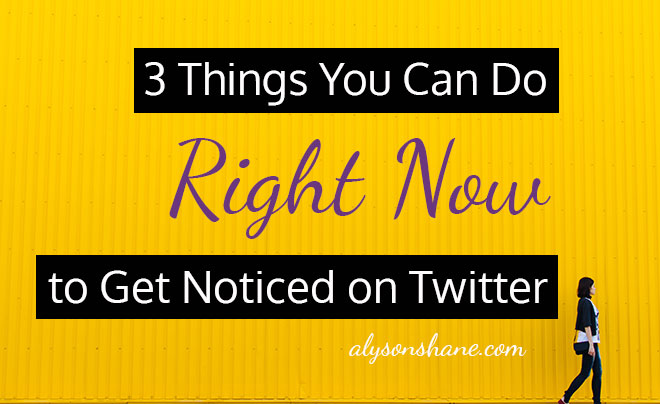
Use strong visual branding
The first thing other Twitter users will see (besides your clever, savvy tweets) is your profile picture. If you can, try to use a hi-quality photo of you that ideally isn't a selfie. As much as I love selfies, they're easy to spot and don't exactly scream "professional internet person."
If you have social media profiles on other networks, try to ensure that your Twitter profile looks similar and fits with the same theme in terms of colours, photos, and descriptive words, as well as including links to your website or blog, if you have one.
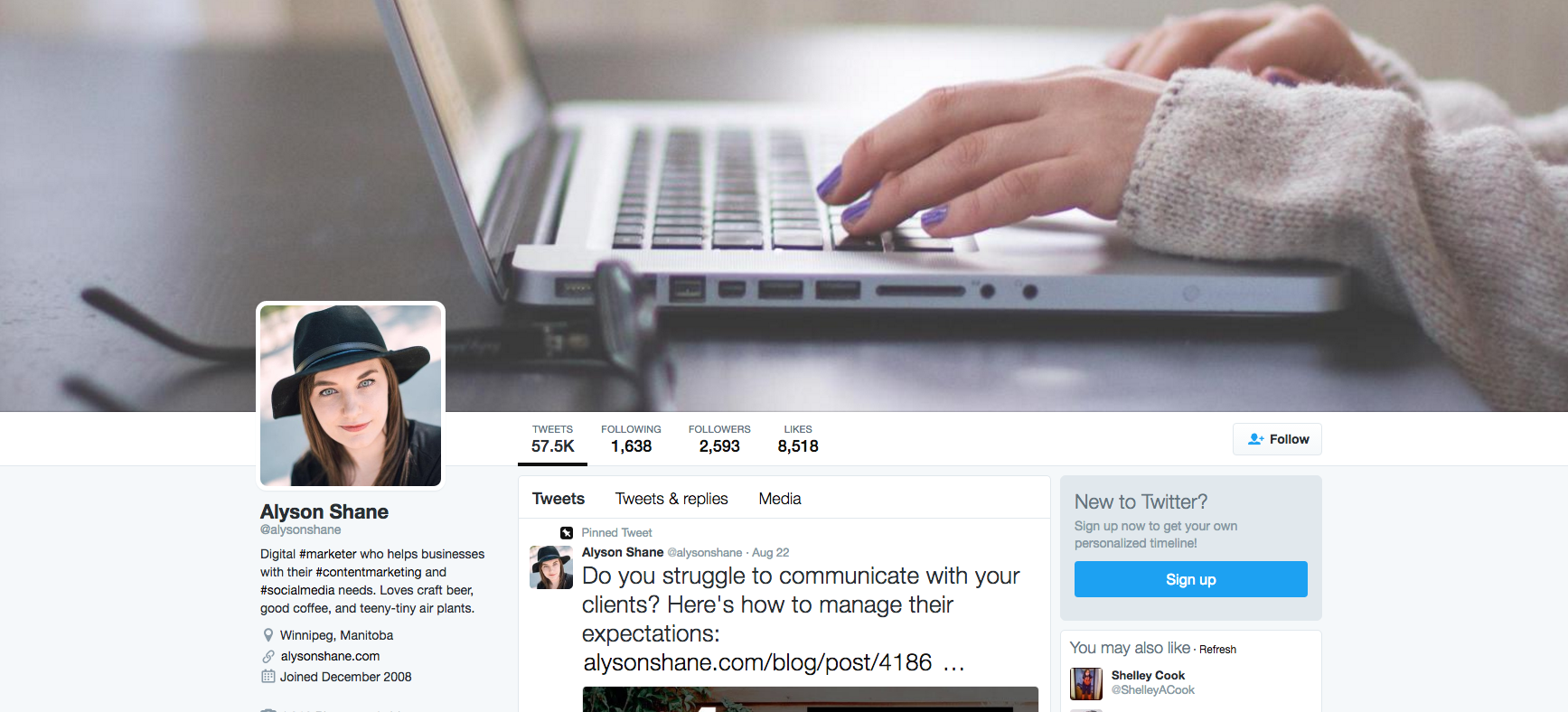
If we take a look at my profile, you can see that I briefly describe what I do for a living, and some stuff I'm into.
This combination of personal and professional works well because other users know what to expect from me in terms of Twitter content, and it's not aggressively sales-y so it doesn't turn off prospective new followers.
Have some variety in your tweets
I have no doubt that you're an interesting, complex, multi-faceted person who loves more than your favourite sports team or binge-watching the X-Files, so why would you limit the stuff you share online to only reflect that one side of your personality?
Because Twitter forces you to be concise it's actually a really great tool for showcasing different interests, thoughts, and opinions. However, it's important to be diverse enough that people don't get bored of your content, and that you're actually engaging with other people.
For example, posting life updates with no context is fine once in a while, but don't crutch on it because most users can't relate to your life, specifically. On the flip side, only sharing memes and gifs doesn't help people get to know you as a person, which is what Twitter is actually for.
Instead, try to post a variety of things from the following topics:
- Random thoughts/life updates
- Links to cool articles and interesting stuff
- Funny gifs and memes
- Stuff relating to your profession (if you're the kind of person who is comfortable talking about their work online)
- Blog posts and other content you've created (if you're a content producer)
- RT's and quoted content
- Tweeting at and replying to other users
Don't abuse hashtags
Hashtags are how users on Twitter (and now other social networks, too) connect their Tweets to a larger shared topic or idea. For example, people tweeting about their long weekend plans will use the hashtag #LongWeekend. That way when people search for hashtags relating to the long weekend, theirs will pop up.
While hashtags are a great way to connect your thoughts to a larger public discussion, they don't look very visually appealing and jamming your tweet with hashtags makes your 140 character message basically impossible to read. If possible, keep hashtags to a minimum and try to use 2-3 at most.
Are you still feeling baffled by Twitter? Then make sure to check out the Twitter for Beginners series, where I break everything down in a handful of easy-to-digest posts for your reading (and future Tweeting!) pleasure.
Do you still have more questions about Twitter and tweeting etiquette? Tell me in the comments!
How to Create Facebook Ads That Actually Get Results
- by Alyson Shane
Facebook is the world's largest social network with more than 1 billion worldwide users, and it's an important social network for businesses to be able to connect with their audiences and share their content.
However, recent changes to Facebook's "timeline" feature presents a challenging problem: many businesses depend on Facebook to connect with their audiences and Facebook's organic reach has been steadily declining. In fact, the company recently announced that it would be curating users' timelines to show even less content from Pages (the business equivalent of a Profile) than ever before.
Shock! Panic! Is this the end of Facebook for businesses?!
Well... no, not really. All it means is that we have to start changing our tactics to meet the shifting demands of the social network, which means spending more time to reach the same number of people that we once (easily) reached for free.

Is Facebook still worth it?
For businesses with Facebook Pages this news may leave you feeling frustrated; after all, now you'll reach fewer people when you publish new content than you did previously. However, it's important to note that users who regularly engage with your posts by liking, commenting, and sharing (aka your "hardcore fans") will still see your content on their timeline on a regular basis.
While this shift in timeline content may feel discouraging, it's important to note that Facebook's users continue to increase every year, which means that it's still a growing and powerful network that deserves your time and attention.
With this in mind, there are basically two things you can do to increase visibility:
Encourage users to share your content
I recommend this to everyone I work with; getting users to share your content is an easy (and free!) way to reach a wider audience and encourage people to like and engage with your page. Contests, promotions, and timely, informational content are all ripe for sharing, but creating this content takes time and isn't all that reliable, because it's difficult to predict exactly what will resonate and get shared, and what won't.
So while I work this kind of content into every content calendar I manage, I strongly encourage my clients to consider...
Paid Facebook Advertising
Facebook's page advertising platform is incredibly powerful, and one of the reasons that I love it is that you can reach a large targeted audience on a daily basis very easily.
Let's say for example you want to promote your restaurant's newest dinner feature. You can use Facebook's Ad Manager to target people in your city with upcoming birthdays and anniversaries who like steak, wine, locally-sourced food, and earn an average annual household income of between $75,000 - $100,00.
Facebook Ads allow you to target exactly the kinds of users you want to see your ad, meaning you get you a direct connection with the kinds of people you want to be coming into your restaurant.
This is the biggest benefit from Facebook advertising: instead of creating a one-size-fits-all ad and hoping that it works, you can target users who live in a specific area, or who have already expressed interest in similar products or services to the ones you're selling.
While many people may still feel frustrated with online advertising, they'll still stop and click on a link if it interests them enough.
Getting started
Every business is unique, and their audiences are unique and will respond differently to different messaging and images, and part of effectively using Facebook Ads is simply making the investment and experimenting with different ads to see which ones will resonate best with your target audience.
With that in mind, here are a few things to remember as you start wading into the big, wide (or small and targeted) world of Facebook Advertising:
- Do your research. If you don't know how to create a buyer persona for your business then check out this post on the subject, then get to making those ads. Otherwise, you won't have any idea who you should be targeting, and you'll waste valuable dollars figuring it out.
- Be patient. As I said, generating the kind of long-term sales and click-through rates that most businesses are looking for takes time. Some campaigns will perform wonderfully; some may flop completely, but it's staying committed to it and learning as you go that will generate real results.
- Test extensively. There are lots of ways to reach the same groups of people: where they work, where they went to school, what their interests are, which Pages they like, etc. Experiment with targeting different interests and see what happens!
- Change up your images. I rarely run a Facebook Ad campaign with fewer than three photos because I like being able to compare and see which kinds of images did better. Not only does this help me understand which images resonated better with people, but it also helps me know which images not to use the next time around.
One last thing...
It's important to remember that a single Facebook Ad won't produce brilliant results overnight. Like social media, blogging, or any other form of advertising (online or otherwise) these things take time. It's a much better long-term business strategy to allocate a monthly "ad spend" budget, and cycle through and try different kinds of ads to see what works.
However, if you can tap into your audience's needs and interests then Facebook Advertising is one of the most powerful weapons in your marketing arsenal, so why not give it a try? (and if you need a hand, drop me a line - I'm happy to help!)
Do you have any tips for Facebook Advertising? Tell me in the comments!
How to Use Twitter to Create Connections & Grow Your Business
- by Alyson Shane
Earlier this week I got together for a mini-tweetup or sorts with some local ladies that I know through a Twitter chat that I participate in. We had some lunch, enjoyed some laughs, and got to know each other a little better.
That experience got me thinking about the value of Twitter as a social network, and how easy it can be for people to find each other, create connections, and even grow their businesses.
As many of you know, Twitter is my favourite social network and I believe that the community I found online helped shape me into who I am today.
With that in mind, I wanted to share some benefits that I believe Twitter can have for you and your business, so let's get started:
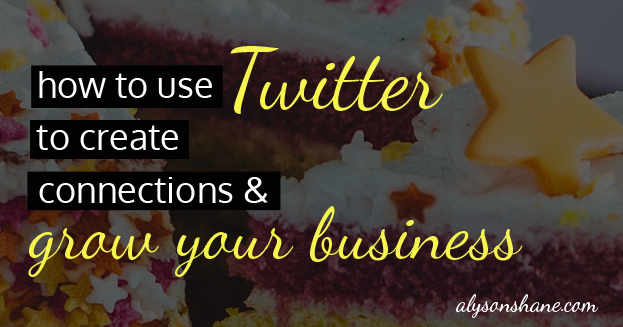
Interact with real people
One of the biggest objections I hear to Twitter is "I'll never meet real people! It's just brands and businesses!"
Not so, young social media Padawans. Not so.
One of my favourite stories to tell about social media was how I met my good friend Colin. I was pretty green to Twitter (circa 2009 or 2010) and I tweeted out something like "are there any meetups for creative types in #Winnipeg?" Colin tweeted at me, we proceeded to meet up at the next Secret Handshake meetup, and we've been friends ever since.
I talk about this a little bit more in my post How Social Media and Blogging Helped Me Discover Who I Am, but it's worth repeating here that Twitter is an excellent conversation tool because it democratizes your feed.
Currently Twitter's timeline is largely comprised of people you follow and you see their tweets in chronological order, allowing you to tweet at basically anyone you want, anytime. This means that you can connect with a celebrity, talk to a brand, or just reach out and start chatting with other people from your hometown, and you're all on the same playing field.
Create genuine, real-life connections
One of the secrets to using Twitter isn't to just tweet and expect people to find you. Sure, replying and RT'ing is a lovely way to let people know that you're out there, but finding twitter and participating in Twitter chats is one of the fastest ways to start seeing connections grow.
Essentially a Twitter chat is a chat hosted on Twitter which uses a chat-specific hashtag (this thing: #) to help users identify and respond to one another. Twitter chats tend to be grouped around themes or topics and can range from chats about beer, to parenting, to disability rights, and more!
One of my favourite weekly chats is #wecmchat, which is hosted by the Women's Enterprise Centre of Manitoba, and focuses on fostering discussion about business ownership and being a woman in business. I've met lots of local lady business owners in the year or so that I've been participating in the chat, and some of us even got together to grab lunch at a burger joint just outside the city:
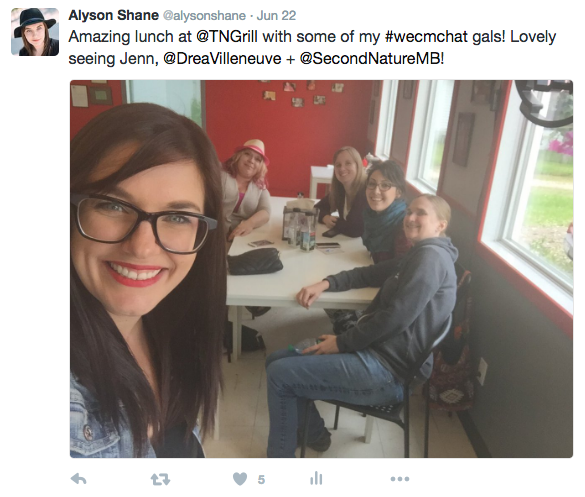
What's great about this chat is that I've met other like-minded people (my "tribe") and have formed connections with them that may not have existed otherwise, and gotten to know them in ways that I may not have if we'd only run into each other face-to-face.
This is the power of Twitter chats: to be able to get to know other people with similar interests, goals, and beliefs in informal and regularly scheduled times.
Grow your business
Twitter can absolutely convert those conversations to paying customers, but you have to put in the effort. Twitter doesn't have a quick ROI, so don't expect to go from 4 followers to 4,000 overnight unless you bought them from somewhere, which is a whole other topic in and of itself.
That being said, Twitter's power lies in its ability to let a business act like a human being. Unlike on Facebook, where business pages can't interact with personal profiles, businesses can Tweet to personal accounts. For example, if you tweet out "today is my birthday!" your local pizza place may tweet back "happy birthday @yournanehere!"
By engaging in conversation with other users businesses can use Twitter as a way to remind people that their business is there, and to create feelings of familiarity and trust as they engage in casual, positive, and non-salesy conversation.*
(*This is super important! While it's okay to tweet out about sales, special promos, and the like, it's bad Twitter etiquette to tweet anything prompting people to buy from you.)
While Twitter may have a slower ROI, it can absolutely land you clients. I can say this with absolute certainty because I've met clients who have followed me on Twitter and decided to use my services as a result. The more time you invest in talking to others and building connections on Twitter, the better your results will be.
More questions?
If you're still totally baffled by Twitter check out my Twitter Crash Course post series. I'll walk you through setting up an account, to connecting with your first followers, understanding your analytics and more!
Click here to view the project index
When it comes to any social network the most important thing to remember is this: everyone else is there to make connections, just like you. So jump right in and start tweeting!
Do you have any questions about Twitter? Tweet at me or ask me in the comments!
4 Tricky Social Media Challenges & How to Solve Them
- by Alyson Shane
Let's face it: social media is challenging, and most people feel totally overwhelmed when they first sign up for a social network without any prior knowledge of how to use it.
This is totally normal, but unfortunately it's the reason that many people sign up for social networks, spend a little bit of time trying to get to know them... and then promptly abandon them when they encounter a challenge (like getting new followers, or having authentic conversations) that they don't know how to overcome.
Stop the madness! While social media can certainly be complicated and feel challenging (trust me, I know) it's not rocket science, and with that in mind I wanted to cover four of the biggest, trickiest challenges that people ask me about on a regular basis.
Let’s jump in!
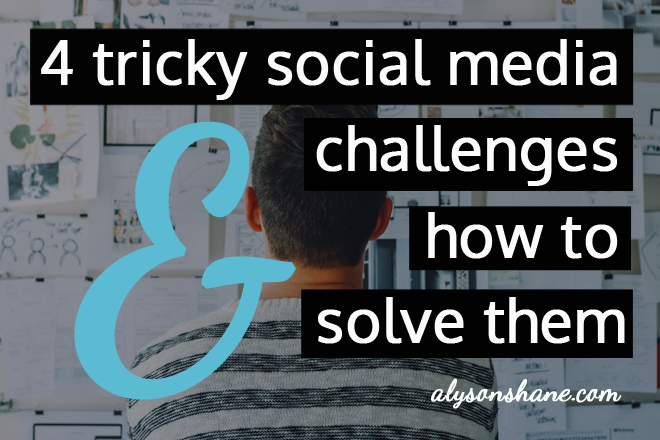
Challenge #1: Creating an authentic connection
One of the things that people seem to struggle with the most when it comes to interacting on social media is authentic interactions. An "authentic interaction" is when a person or brand takes the time to get to know their audience on a personal level by interacting with them in a natural, non-salesy way, and is an important part of building feelings or trust and familiarity online.
How to solve it
The easiest way to create an authentic connection online is to be legitimately interested in other people, and to engage with them in a variety of positive ways. These can include:
- Asking questions
- Sharing links to articles and blog posts
- Responding to posts, tweets and comments
- Offering advice or a solution to someone's problem
One of my favourite ways to engage with other people is to find relevant Twitter chats and participate regularly. Never participated in a Twitter chat? Don't worry, I have a whole series called the Twitter Crash Course to get you started.
Challenge #2: Developing a social media strategy
Most people are on social networks without much of a plan, but when you make the decision to start investing the time and energy into growing your audience, it's time to sit down and start planning how to do it.
How to solve it
There are lots of things that you can do to pave your path to social media success, but a few of the most basic ones you ought to have figured out before diving in are:
- Why you're on social media. Don't just say "because everyone else is"! Legitimately ask yourself why you want to invest your time growing an online audience and let those goals guide your actions.
- How you're going to achieve those goals. Maybe you'll put together a kickass paid advertising campaign, maybe you'll start sharing hilarious cat videos, whatever the case may be.
- How will you measure success? There are lots of ways you can measure success: number of page views, tweets, responds etc over a specific period of time, etc. What matters is that you keep records (I do mine on a monthly basis) to track your progress.
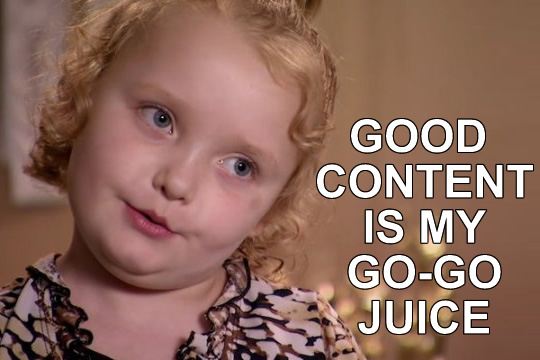
Challenge #3: Creating engaging, quality content
If you think that consistently coming up with good, consistent content for your social media feeds and blog is challenging and time-consuming... well, you're right. In fact, it's exactly why people like me exist: because most people simply don't have the time to create, update, curate, monitor, respond, and schedule content across multiple social media profiles.
But if you're not ready to invest in someone else handling your content for you, it can feel like an overwhelming amount of work, and is often something that leads to people avoiding or abandoning their social profiles entirely.
How to solve it
One of my favourite ways to suss out high-quality content ideas is to use a great tool called Buzzsumo, which allows you to punch in topics or websites and see the most popular posts about those topics. You can also try finding relevant Twitter chats and paying attention to what people discussing your industry or products are asking, or searching forum websites for questions and discussion threads.
When posting articles, make sure to use eye-catching images whenever possible; if you're sharing a link an image from the page will usually auto-generate (it's usually fine to just use these instead of your own), but if you're posting links to your own blog posts and content, take the time to create a unique and original image to go along with it.
Challenge #4: Getting the word out about your content
Unfortunately setting up a blog and social feeds doesn't necessarily mean that people will immediately flock to you (I wish it were that easy!) - you'll have to hustle your content in order for people to know that it's there. No matter how great your content may be, if you aren't promoting it then nobody is likely to find it.
How to solve it
The trick to getting your content out there is to be proactive in sharing it and encouraging other people to share it, as well. Try and identify people who would benefit from seeing your content and make a point to share it with them. There are a few ways that you can accomplish this:
- Share your blog or website updates on social media.
- Reach out to influencers in your industry (in a nice, non-sleazy way) and ask them to share it or work with you to promote your content.
- Tag people you mention in your post. For example, last year I wrote a post about the Winnipeg Folk Festival and tagged them in the tweet, which they retweeted and subsequently earned me a lot of traffic.
- Post links to your content on relevant Facebook or LinkedIn groups, Pinterest groups, and forum websites like Reddit and HackerNews (be sure to mind the posting rules on these sites!)
- Repost your content on Medium.com, and reach out to publications to see if they would be interested in republishing your work.
There you have it! Four steps to social media success and overcoming some of the trickiest obstacles that people face when they first start wading out into the big, wide world of social networks.
Do you have any social media challenges you struggle to deal with, or tips for overcoming some of these tricky issues? Tell me in the comments or tweet at me!
6 Ways Your Small Business Can Save Money
- by Alyson Shane
Recently I received a phone call from my alma mater asking for donations to their Faculty of Arts, where I studied when I received my BA. She asked me for $5 a month, or "the cost of a single Starbucks coffee" (well played, University of Winnipeg, well played).
I'll be honest with you: I declined to give back to the university for the time being. My business is still in it's infancy, and saving money is pretty important to me right now. However, this conversation got me thinking about the ways I work to keep costs low for myself during this stage (even if that means saving that $5 a month), and I thought I'd share some of the things I've learned:
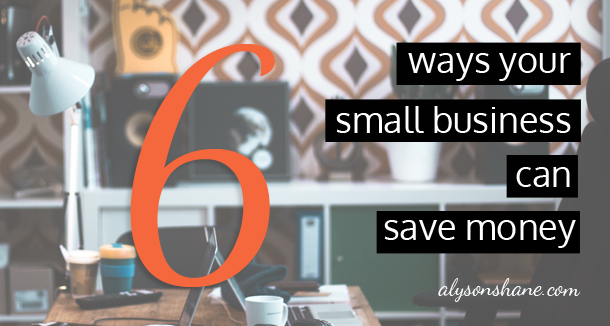
One of the most interesting assumptions that people have started to make about me since I began running my business is that this is the lifestyle I lead:

This is, much to my chagrin, not how I live my life. In fact, it's a little more like this:

Don't get me wrong, I'm doing just fine financially, but I'm not baller status quite yet. As a result, here are some of the areas where I cut costs or try not to indulge in order to keep my business expenses low:
Buying or renting space you don't need yet
One of the easiest ways to save a few hundred dollars a month (minimum!) is to avoid buying a brick-and-mortar store or renting office space for as long as you can. This, in my opinion, is the single biggest benefit to working from home.
Sure, there are benefits to an office or renting a desk in a co-working space, such as access to a board room, printing area, etc, but unless your business has grown to the point where you need those things on a consistent basis, having client meetings in coffee shops should be fine for now.
Spending on expedited shipping
Unless it's a business emergency (ie: your business will shut down without this parcel/package) you can wait the extra day or two.
Additionally, if the shipping charges for a particular item are outrageous, ask yourself: do you really need that beautiful embossed day planner that badly? Odds are, you probably don't.
Custom website design
I get it: you want to build a website that stands out from your competitor's. You want something that is completely yours, and is an accurate online representation of your business and your values.
However, what's more important is simply having a website, rather than worrying about whether or not it's built custom from scratch. Many people choose to work with existing Wordpress or Squarespace templates, which are easy to alter and personalize without the investment in a custom designed site.
Unnecessary advertising
I'm a firm believer that the best thing a person or business can do for themselves is to start to build a positive reputation for themselves online. What's great about this is that social networks like Facebook, Twitter, LinkedIn and Pinterest (the biggest and most popular ones for businesses) are all free to join.
This means that if you do hustle a little bit (or hire someone like me #ShamelessPlug) you can start to build a name for yourself and your services without having to invest in paid advertising just yet.
Not only does putting off doing paid advertising beneficial because it keeps costs low, but people will appreciate that you're connecting with them on a real, human level, and not just sending a barrage of ads their way.
Office supplies you don't need
Confession: I LOVE going to stationery stores. Every time I step into Tiny Feast here in Winnipeg my heart starts going pitter-pat and I start imagining how charming my desk would be with all those fountain pens, notebooks, staplers... you get the drift.
As much as I would love to take everything from Tiny Feast home with me, I have to ask myself: how often do I use a stapler (never), how often do I use paperclips (also never), do I really need a handmade mug to store my pens (not at all)... you get my drift.
As tempting as it may seem to try and pimp out your desk with heaps of Pinterest-worthy goodies, resist the temptation for now. You can always indulge in that gorgeous cork-top desk in the future.
Subscriptions for software you don't need
This one always gets me. I pay for a few subscriptions to various content scheduling and monitoring services (HootSuite, Buffer, etc) and it sucks to pay the monthly fees... but without them I would go absolutely bonkers and not be able to manage my shit. So, for me they are a necessary evil.
However, unless you're in the digital marketing business odds are you can avoid a lot of these monthly expenses by using free software to do what you need. Some great options are:
- Insightly (CRM system)
- Freshbooks (accounting)
- HootSuite or Buffer (free versions - social media management)
- Toggl (time management - I'd be lost without this tool)
- Trello (project management)
- Dropbox (file sharing)
It may seem tempting to invest in expensive software, or to buy a bunch pf products up-front "just in case" but if you aren't using the tool on a daily basis, and if it isn't something that your business can live without (eg: I would be utterly lost without Buffer, for example) then consider sticking with the free version, or finding a free alternative until the time comes when you either a) need the service enough that you should pay for it or b) you can afford to invest in it.
Do you have any money-saving tips for small businesses? Is there something that you wish you had learned when you were starting out? Tweet at me or tell me in the comments!
